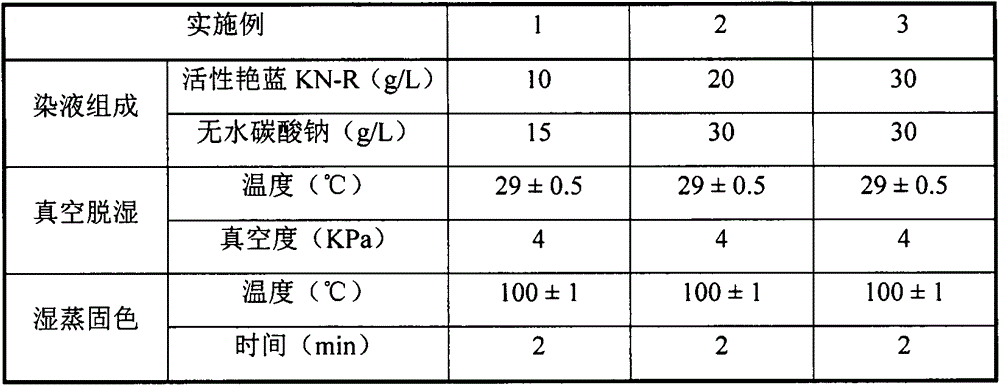Padding, wet steaming and dyeing method of reactive dye
A technology of reactive dyes and dyeing methods, applied in dyeing methods, textile material processing, removal of liquid/gas/vapor, etc., can solve the problems of adverse effects on dyeing and color fixing, hydrolysis of reactive dyes, consumption of large heat energy, etc. To achieve the effect of shortening wet steaming and fixing time, reducing hydrolysis and accelerating heating rate
- Summary
- Abstract
- Description
- Claims
- Application Information
AI Technical Summary
Problems solved by technology
Method used
Image
Examples
Embodiment 1~3
[0022] The dyeing process of Examples 1-3: padding dye solution (two dipping and two padding)→vacuum dehumidification→wet steaming to fix the color.
[0023] The dye liquor was prepared according to the dosage of the dyestuff mentioned in Table 1, and the corresponding vacuum dehumidification and steam fixation were carried out on the cotton fabric dipped in the dye liquor.
[0024] The dye liquor composition and dyeing process condition of table 1 embodiment 1~3
[0025]
[0026] With conventional pad-dry-steaming process and pad-steaming process to carry out the experiment of cotton fabric reactive dye dyeing as control group, dye solution prescription is identical with embodiment 1,2,3 respectively, and dyeing process is:
[0027] Pad-dry-steam process: Pad dyeing solution (two dipping and two pads)→pre-drying (80°C, 3min)→atmospheric saturated steam steaming and fixing (100±1°C, 2min)
[0028] Pad-steam process: Pad dyeing solution (two dips and two pads) → atmospheric...
PUM
 Login to View More
Login to View More Abstract
Description
Claims
Application Information
 Login to View More
Login to View More - R&D
- Intellectual Property
- Life Sciences
- Materials
- Tech Scout
- Unparalleled Data Quality
- Higher Quality Content
- 60% Fewer Hallucinations
Browse by: Latest US Patents, China's latest patents, Technical Efficacy Thesaurus, Application Domain, Technology Topic, Popular Technical Reports.
© 2025 PatSnap. All rights reserved.Legal|Privacy policy|Modern Slavery Act Transparency Statement|Sitemap|About US| Contact US: help@patsnap.com


